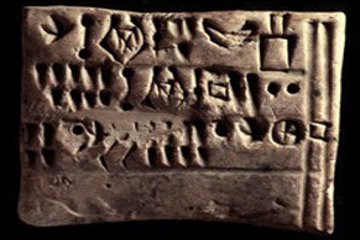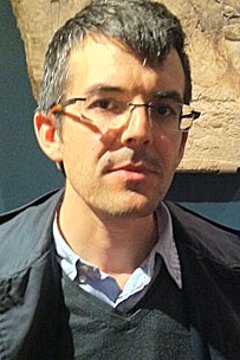The Breakthrough that Isn't
Human justice having proved inadequate, we must hope that there is a special corner of hell reserved for headline writers. Of course, we can hope for an equally special corner of heaven for some headline writers: the author of "Police Begin Campaign to Run Down Jaywalkers" deserves a special reward, as does "Miners Refuse to Work after Death". One suspects an apocryphal element in "Two Convicts Evade Noose, Jury Hung" while the innocent who trumpeted "Infertility Unlikely to be Passed On" deserves immortality, if only so that he can be taught the facts of life!
No, my ire is reserved for those who write misleading or even false headlines, just so that they can con the trusting public into reading a not-very-interesting article. Such, for example, was the headline which caught my eye as I browsed through the BBC website the other day. "Breakthrough in World's Oldest Undeciphered Writing" it proclaimed and naturally I made a beeline for the story, thinking that at last Linear A has been understood.
No such luck!
I suppose that the "world's oldest undeciphered writing" part was correct: the script in question is known as proto-Elamite and dates back to 3200 BC by conventional chronology, which is indeed older than Linear A by some years.
It would seem that the ancient Elamites heard of the breakthrough by their neighbours in the plains of Mesopotamia, who had developed a system of recording things by pressing a stylus into clay. It is even possible that in their frequent raids on their neighbours, the Elamites may have brought back a clay tablet or two or even an unfortunate scribe or two. If so, they were intelligent enough to realise the usefulness of this new art and wish to utilise it.
It would have been easy to sit down with one of those scribes - or if they had already been killed and eaten (or whatever Elamites did with those unfortunate enough to fall into their hands) - to send an emmisary down into the plains to find out how it was done. There would have been nothing demeaning about doing this: other nations and cultures did it, from proud Persians to thuggish Assyrians to mysterious Hittites. All wrote their own languages in the cuneiform script in much the same way as French, Germans, Turks and Americans use and adapt the Roman script for their own tongues.

| |
| A typical example of the approximately 1,600 proto-Elamite tablets in existence today. |
No, the Elamites had to be different. They sat down and developed their own script, a series of dots, scratches and wedges that have so far baffled all attempts at decipherment. One reason is that the script only lasted for some four centuries, which means that there was no time for the usual aids of grammars and bilingual dictionaries that have so helped us in deciphering other scripts. Even worse, because the Elamites were not particular favourites in the ancient world, there are no bilingual tablets or inscriptions - no one wanted Elamite on their own inscriptions and the Elamites saw no reason to put any other language on theirs!
However the recent study of the script has brought up another possible reason: like spotty teenagers of our modern era, the Elamite scribes were not unduly bothered about trifles like spelling and grammar. Those who have studied the tablets most carefully are convinced that the authors were not above writing "b4" for "before" and "innit" instead of "isn't it".
Of course, it is always possible that the idiosyncratic script and the "alternative spellings" (a kinder way of saying, "misspellings") were purposeful choices with the deliberate intention of preventing non-Elamites reading what they had written. Proto-Elamite served a wide-ranging empire that stretched over most of modern Iran from the Elamite capital of Susa or Shushan, as far as Tehran. It may well be that proto-Elamite was the diplomatic code of the day, in which case the ancients are to be congratulated: they have kept their secrets better and longer than the Germans did with the Enigma code!
Which brings us to this "breakthrough". According to the article, a team working in the Ashmolean Museum, Oxford, are busy photographing hundreds of proto-Elamite tablets using a special piece of apparatus on which we reported back in 2001.
Invented by a certain Tom Malzbender, the device consists of a black dome in which are placed 50 light sources. 50 high resolution digital photographs are then taken with the tablet lit in turn by each of the 50 lights. Clever software then combines all the photographs and enables you do drag with your mouse and see what the tablet looks like when lit from any angle (including some that are physically impossible!) or to digitally coat the tablet with a variety of reflective or non-reflective surfaces, so that anything from matt velvet to shiny silver is possible. Thus the faintest impression on a badly worn tablet can be teased out.

| |
| Dr Jacob Dahl, who is leading the team photographing proto-Elamite tablets with the 'Reflectance Transformation Imaging System'. |
The Ashmolean team, led by Dr Jacob Dahl, is using a later version of this device, one with 76 lights instead of a mere 50. This is hardly a "breakthrough" - though my experience of the toffee-nosed snobs at the Ashmolean is such that I am quite prepared to believe that they, rather than the BBC reporter's fertile imagination, are responsible for the term.
Dahl claims that so far he has identified some 1,200 signs, mainly numbers, which are very similar to cuneiform numerals, and those few symbols which are stylised pictures of the object they represent. Basic nouns such as "cow" or "cattle" have so far eluded him, though he is sure they must exist in the language. The words that he has decoded point to a poverty-stricken society - which may, of course, explain why the Elamites were in the habit of descending from their barren hills and raiding the fertile plains of Mesopotamia.
The upper crust of Elamite society bore titles which reflected their level of wealth. "Mr One Hundred", for example, is thought to have had one hundred workers under his control. Presumably these were the Elamite lower classes, though from the way they were treated they may as well have been slaves. While Mr One Hundred dined luxuriously on meat, yoghurt, honey, cheese and bread, his underlings made do with a porridge of cracked barley and none too much of it, either. According to Dr Dahl, your average Elamite hovered just above the starvation level!
Of course, Dr Dahl hopes that by photographing these tablets he will be able to examine them better and perhaps extract nuances in the symbols that he might otherwise have missed. However he has another reason for digitising them.
As Confucius probably never said, "Many hands make light work" - or as Scripture actually does say, "In the multitude of counsellors there is wisdom". Dr Dahl intends to put the pictures on-line and then invite the public to view them and come up with their own ideas on what the symbols mean. (Presumably he will also put a summary of the signs he has identified to provide a foundation on which others can build - unless, of course, he is not entirely certain about his work and wants to see it confirmed by others, which would be entirely reasonable.)
A major difficulty in tackling the script, however, is the fact that no one is entirely sure what language is written by it. It is called "proto-Elamite" because examples of the script were first found in Susa, the Elamite capital, and in fact the majority of proto-Elamite tablets - 1500 out of 1600 - have been found there. Others have claimed that in view of the fact that the script is found outside the area ruled by the Elamites (so far as we know, of course), it should really be called proto-Persian. So does the script record Elamite or Persian?
Dr Dahl is heavily involved in the Cuneiform Digital Library Initiative which is a highly commendable project that seeks to make all cuneiform tablets in the world's museums available to everybody, not just the few scholars who can travel to some minor museum on the other side of the world. In particular, the Initiative will benefit less well-off scholars from the lands which gave birth to cuneiform, so we particularly wish Dr Dahl and his colleagues well in their work.
spotty teenagers Or my other bete noir, the person who claims to be dyslexic. Have you noticed that these people, who cannot spell "there" correctly, yet invariably manage to spell the name of their supposed complaint without an error? Point out some egregious howler in their spelling and the maladjusted moron, who spent his time at school bullying teachers and fellow pupils alike, whines, "I can't help it; I'm dyslexic."
Now there are certain characteristic mistakes made by genuine dyslexics and the word "dyslexic" has room for four of them (but I'm not going to tell you what they are, otherwise these posers would memorise them and reproduce them in their pitiful whingings), yet out it comes every time, correctly spelled: dyslexic. As Scrooge would have said, though with far less reason, "Bah, humbug!" Return
toffee-nosed snobs I hasten to add that I have never met Dr Dahl and for all I know, he is a very nice man. Even better, he is Wolfson Fellow and Lecturer in Assyriology and has nothing to do with the Ashmolean other than using it as a convenient base for his photographic activities.
I refer rather to the fact that on my second visit to the Ashmolean a ban on photography had been introduced. There were a couple of things I particularly wished to photograph and when I politely asked for permission to take my pictures, it wasn't just the refusal but the arrogant manner in which the refusal was given, that roused my ire. If some Biblical catastrophe were to overtake the Ashmolean I would lament over the loss of the priceless objects it contains, but I would be inconsolable if I discovered that any of the staff had escaped. Return
© Kendall K. Down 2012





